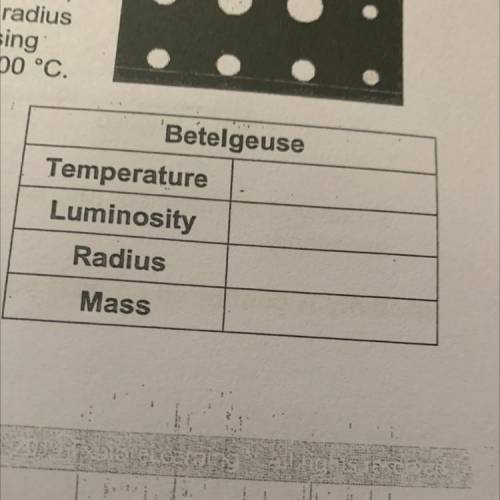Gizmo Warm-up
In the early 1900s, astronomers were able to identify many star
characteristics...

Chemistry, 15.04.2021 01:00 jazminecrosby
Gizmo Warm-up
In the early 1900s, astronomers were able to identify many star
characteristics such as color, size, temperature, and
luminosity-or how bright a star is. Using the H-R Diagram
Gizmo™M, you will discover how some of these characteristics
are related
Start by moving your cursor over the stars in the Star
collection. Information about each star is displayed on the right
side of the Gizmo. The numbers given for Luminosity, Radius,
and Mass are in comparison to the Sun. So, a star with a radius
of 2 is twice as large as the Sun. Temperature is given using
the Kelvin scale, where 273.15 K= 0 °C and 373.15 K = 100 °C.
1. Find Betelgeuse in the Star collection. Fill out the
chart at right.
Betelgeuse
Temperature
Luminosity
Radius
Mass
2. The Sun has a radius of 695,500 km. X 1,000
What is the radius of Betelgeuse? 617.1 mm


Answers: 3
Another question on Chemistry

Chemistry, 22.06.2019 01:00
What are the variables in gay-lussac’s law? pressure and volume pressure, temperature, and volume pressure and temperature volume, temperature, and moles of gas
Answers: 1

Chemistry, 22.06.2019 09:00
Which process does not require the presence of a physical substance in order to transfer heat? air in the atmosphere is heated by the ground. this warm air then rises, and cooler air falls. this is an example of what type of process? how is conduction different from radiation?
Answers: 1


Chemistry, 22.06.2019 10:30
Consider the following reactions. (note: (s) = solid, (l) = liquid, and (g) = gas.) mg(s) + ½o2(g) → mgo(s) + 146 kcal/mole h2(g) + ½o2(g) → h2o(g), δh = -57.82 kcal/mole what type of reaction is represented by the previous two examples?
Answers: 3
You know the right answer?
Questions



Mathematics, 26.07.2019 09:50


Mathematics, 26.07.2019 09:50

Mathematics, 26.07.2019 09:50





Mathematics, 26.07.2019 09:50


Arts, 26.07.2019 09:50


History, 26.07.2019 09:50







